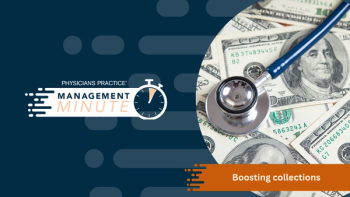
If You Do It, Get Paid for It
It's a convenience for your patients and a source of revenue for you. But how do you code and bill for minor in-office surgical procedures? Here are some expert tips.
Many primary-care physicians perform minor surgical procedures in their offices. It's convenient for patients and a source of revenue. But to get paid, you have to know the coding rules.
What's included?
First, you must understand what's included in the global package for a surgical procedure - that is, everything that is included in the one surgical code - and what you can charge extra for. The global surgical package includes a preoperative evaluation and management (E&M) service on the day of the procedure (unless the E&M meets the criteria for a -25 or -57 modifier), the intraoperative work, and the follow-up service for a set number of global days. Minor surgical procedures typically have zero or 10 global days. That is, if the service has 10 global days, any follow-up care related to that procedure for 10 days is included in the fee for the service; you can't bill separately for it. If a procedure has zero global days, no follow-up care is included in the fee for the service.
Your surgical codes also include preparing the patient, sedation by the physician doing the procedure, local, topical, or regional anesthesia, the surgical approach, obtaining cultures, dressings, drains, closure, and documentation of the service. Medicare does not pay for a surgical tray, although some private insurers may pay.
Don't waste time charging separately for performing tasks that are included in the surgical package. But do make sure to charge for the work you do that isn't included.
Use the right code
Also, make sure you use the correct and most specific CPT code when you bill. Remember that code descriptions are shortened to fit on your encounter form. Busy doctors too often just pick one of the abbreviations instead of looking for a CPT book and finding the complete descriptions. Do yourself a favor and search the book for the procedures you do most often.
Here's one common way physicians mess up coding: destroying lesions. When destroying lesions (not excising them), select the code by the type of lesion, not by the method of destruction.
When you destroy benign or premalignant lesions by any means - for example, laser surgery, electrosurgery, cryosurgery, chemosurgery, or surgical curettement - use code series 17000-17004. If using any of the means listed above but destroying flat warts, molluscum contagiosum, or milia, use codes 17110-17111.
If you shave epidermal or dermal lesions, use code series 11300-11313. These codes are selected by location and size.
Skin tag removal has a different set of codes. Skin tag removal is considered cosmetic surgery by most payers, unless the skin tags bleed or are irritated by clothing. Since these are often denied, obtaining a waiver of liability before removing skin tags is a good practice. Skin tag removal codes are 11200 and 11201.
When measuring the size of the lesion to select a code, do not simply measure the lesion size. Measure and count the margins, too. According to the CPT book, "Code selection is determined by measuring the greatest clinical diameter of the apparent lesion plus that margin required for complete excision (lesion diameter plus the most narrow margins required equals the excised diameter)." Always document the size of the lesion and the margins in the medical record.
Also, be careful about the units for these procedures. They are not consistent from one set of codes to the other. When coding units, if the CPT description is "each" or "each additional," bill the actual number of lesions. When the coding description is 2-14 or 15 or more, use 1 as the number of units. Be careful. The code descriptors are not consistent.
Physicians often remove lesions that are sent to pathology for a biopsy. When the lesion is removed, the physician doesn't know if the lesion is benign or malignant. However, the CPT book has different codes for benign and malignant lesions, and the payment varies for each. In these cases, the office must wait to bill for the excision until after the pathology report is returned to the office. These benign and malignant codes are selected by size and location. Physicians can bill for intermediate or complex laceration repair in addition to removal when the benign or malignant lesion removal requires more than simple closure. The diagnosis code for the lesion should match the procedure code. That is, if the specimen is benign, use the benign lesion removal codes and a diagnosis that indicates a benign lesion.
There are two biopsy codes listed in the minor surgical procedure section of the CPT book. These are 11000, biopsy of skin, subcutaneous tissue and/or mucous membrane, (including simple closure), unless otherwise listed; single lesion and 11001, an add-on code for each separate lesion. Do not bill these in addition to the excision codes. Collecting a specimen is considered part of an excision of a benign or malignant lesion. Use these codes only if a biopsy is obtained on a separate lesion, at a separate site, on the same date.
I'm often asked how to bill for removal of a foreign body. There are two codes for foreign body removal of subcutaneous tissues - simple and complicated. Both require incision and removal. That is, if you can remove the foreign body without an incision from the subcutaneous tissue, do not use codes 10120 or 10121. Bill that with an E&M visit.
Cryotherapy for acne is billed using code 17340. Chemical exfoliation for acne is coded as 17360.
Many primary-care physicians perform laceration repairs in their offices, as well. The method of closure is not a factor in code selection unless only adhesive strips are used. Wound closure using only adhesive strips should be coded with an E&M code. Wound closures are defined as simple, intermediate, and complex. The complete definitions of these can be found in the CPT book.
A simple closure involves primarily the epidermis, dermis, or subcutaneous tissues and requires simple, one-layer closure. An intermediate repair requires a layered closure of one or more of the deeper layers of subcutaneous tissues and superficial fascia, in addition to the skin closure. Heavily contaminated wounds that require single-layer closure may be billed as intermediate. Complex repairs include wounds requiring more than layer closure, such as scar revision, debridement, extensive undermining, stents, or retention sutures.
When repairing wounds, document the size and location in the medical record. Add together wound lengths for multiple wounds in the same classification. For example, two simple arm wounds, one 5.5 centimeters in length and the second 4.5 centimeters in length, would be billed using the single CPT code 12004, simple repair of superficial wounds of scalp, neck, axillae, external genitalia, trunk and/or extremities of 7.6 centimeters to 12.5 centimeters. When more than one classification of wound is repaired - for example, an arm wound and a facial wound - bill each separately. Bill the procedure with the lower RVU value with a -51 modifier.
Another common procedure is arthrocentesis, aspiration and/or injection of a joint. When billing for an injection, be sure to bill for the medication that was injected in addition to the procedure. Be careful about the units when billing for an injection. If the code description is "20 mg equals 1 unit," and you inject 40 milligrams, bill two units. These medication definitions are found in the HCPCS book.
Billing procedures with an E&M
One of the most confusing questions is whether to bill an office visit on the same day as a minor surgical procedure.
An office visit is payable if it meets the criteria of a significant, separately identifiable service performed on the same day as the procedure. That is, does the documentation support a medically necessary, distinct history, exam, and medical decision-making, in addition to the procedure? A different diagnosis is not required, but it does support the fact that the office visit is "separate."
In general, you can feel more comfortable billing an E&M service if the patient is a new patient or a consult, and you do a minor procedure. Repeat procedures are less likely to require an office visit on the same day. For example, a patient with non-healing wounds is referred to a wound care center. At the time of the first visit, the physician assesses the patient's vascular status, medical history, and the wound itself, as well as debriding the wound. If documented appropriately, the consult or office visit can be billed with a -25 modifier along with the debridement. At this visit, the physician asks the patient to return in one week. At the second visit, the patient's wound is improved and the physician again debrides it. At that visit, the history is mostly a "recap" from before. The second procedure was scheduled at the previous visit. Bill only the procedure at the second visit. However, if at the second visit the patient had developed an infection or a second wound, or had a significant decrease in his vascular function, you could bill an office visit.
Secrets of success
What can your practice do to make sure that these services are billed correctly? Most importantly, look at your encounter form. Make sure that the descriptions on your encounter form are complete and up to date. If the descriptions are abbreviated, remove them altogether. Consider a separate encounter form, just for surgical procedures, that leaves sufficient room for the full descriptions.
Leave spaces that prompt you to list what was removed/excised, the location, and the size of both the lesion and the margins. If your practice performs many such procedures, consider coding them from the physician documentation, rather than from the encounter form. This will improve the accuracy of the coding.
Finally, be sure coders or billers in your office review the documentation and give feedback to the providers. If the provider is not documenting the size of the margins along with the size of the lesions, you could be losing money. Make sure providers don't select an E&M service when they have actually performed a procedure because it's "easier" or quicker. Give them the tools they need to bill and be paid for the procedures they perform.
Betsy Nicoletti is the author of 2005 Physician Auditing Workbook, and is a speaker and consultant in coding education, billing, and accounts receivable. She can be reachedat
This article originally appeared in the July/August 2005 issue of Physicians Practice.
Newsletter
Optimize your practice with the Physicians Practice newsletter, offering management pearls, leadership tips, and business strategies tailored for practice administrators and physicians of any specialty.














